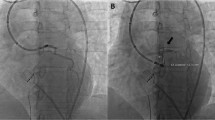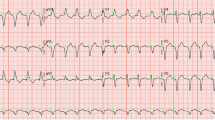Abstract
Introduction: Biventricular pacing system implantation is a time-consuming and challenging procedure. A critical step in biventricular pacemaker implantation is coronary sinus (CS) cannulation. CS cannulation can be achieved either using dedicated guiding catheters (guiding catheter alone positioning strategy, GCA) or with the aid of an electrophysiology catheter advanced inside the guiding catheter (electrophysiology catheter aided positioning strategy, EPA).
Aim of the study: To evaluate whether the EPA technique is useful for reducing CS cannulation time compared to a conventional GCA technique.
Methods: Thirty-four consecutive patients were randomly assigned to the GCA (18 patients) or EPA (16 patients) CS cannulation strategy.
Results: Time to successful catheterization of CS was 5.0 ± 2.4 min in the EPA group versus 10.1 ± 5.4 min in the GCA group p = 0.004. Fluoroscopy time was 4.6 ± 2.3 min in the EPA group versus 9.2 ± 4.9 min in the GCA group p = 0.004. Total contrast dye volume to search and engage the CS ostium was 0.0 ml in the EPA group versus 14.3 ± 3.4 ml in the GCA group p < 0.001.
Conclusions: Cannulation of CS with the adjunct of an electrophysiology catheter to dedicated delivery systems significantly reduces procedural time, fluoroscopy time and contrast dye volume compared to a conventional strategy.
Similar content being viewed by others
References
Cazeau S, Leclercq C, Lavergne T, Walker S, Varma C, Linde C, Garrigue S, Kappenberger L, Haywood GA, Santini M, Bailleul C, Daubert JC; Multisite Stimulation in Cardiomyopathies (MUSTIC) Study Investigators. Effects of multisite biventricular pacing in patients with heart failure and intraventricular conduction delay. N Engl J Med2001;344:873-880.
Abraham WT, Fisher WG, Smith AL, Delurgio DB, Leon Ar, Loh E, Kocovic DZ, Packer M, Clavell AL, Hayes DL, Ellestad M, Trupp RJ, Underwood J, Pickering F, Truex C, McAtee P, Messenger J; MIRACLE Study Group.Multicenter InSync Randomized Clinical Evaluation.MIRACLE study group: Multicenter inSync randomized clinical evaluation. Cardiac resynchronisation in chronic heart failure. N Engl J Med2002;346:1845-1853.
Leclercq C, Kass D. Retiming the failing heart: Principles and current clinical status of cardiac resynchronization. J AmColl Cardiol2002;39:194-201.
Curnis A, Neri R, Mascioli G, Cesario AS. Left ventricular pacing lead choice based on coronary sinus venous anatomy. Eur Heart J(suppl) 2000:J31-J35.
Ricci R, Ansalone G, Toscano S, Pignolberi C, Lunoti M, Gaspenini M, Podeletti L, Disertori M, Ravazzi PA, Santini M. Cardiac resynchronization: Materials, technique and results. The InSync Italian Registry. Eur Heart J(suppl) 2000;2:J6-J15.
Purerfellner H, Nesser HJ, Winter S, Schwierz T, Hornell H, Maertens S. Transvenous left ventricular lead implantation with the EASYTRAK lead system: The European experience. Am J Cardiol(suppl) 2000;86:K157-K164.
Sayad DE, Sawar A, Curkovic V, Gallardo I, Barold SS. Simple access to the coronary venous system for left ventricular pacing. PACE2003;26:1856-1858.
Walker S, Levy T, Rex S, Brant S, Paul V. Initial United Kingdom experience with the use of permanent biventricular pacemakers: Implantation procedure and technical considerations. Europace2000;2:233-239.
Walker S, Levy T, Rex S, Paul V. Initial results with left ventricular pacemaker lead implantation using preformed “peel-away” guiding-sheat and “side-wire” left ventricular pacing lead. PACE2000;23:985-990.
Sack S, Heinzel F, Dagres N, Enger S, Auricchio A, Stellbrink C, Neuzner J, Potty P, Maarse A, Tockman B, Michel U, Erbel R. Stimulation of the left ventricle through the coronary sinus with a newly developed “over the wire” lead system: Early experiences with lead handling and positioning. Europace2001;3:317-323.
Proclemer A, Zanon F, Facchin D, DePorto AE, Gras D, Duby C. Can a comprehensive family of catheters be helpful in achieving implant success. PACE2002;25(4), Part II:690.
Butter C, Gras D, Ritter P, Stellbrink C, Fleck E, Tockman B, Schubert B, Pochet T, deVoogt W. Comparative prospective randomized efficacy testing of different guiding catheters for coronary sinus cannulation in heart failure patients. J of Interv Card Electrophys2003:9,343-351.
Author information
Authors and Affiliations
Corresponding author
Rights and permissions
About this article
Cite this article
De Martino, G., Sanna, T., Russo, A.D. et al. A Randomized Comparison of Alternative Techniques to Achieve Coronary Sinus Cannulation During Biventricular Implantation Procedures. J Interv Card Electrophysiol 10, 227–230 (2004). https://doi.org/10.1023/B:JICE.0000026916.15278.2e
Issue Date:
DOI: https://doi.org/10.1023/B:JICE.0000026916.15278.2e




